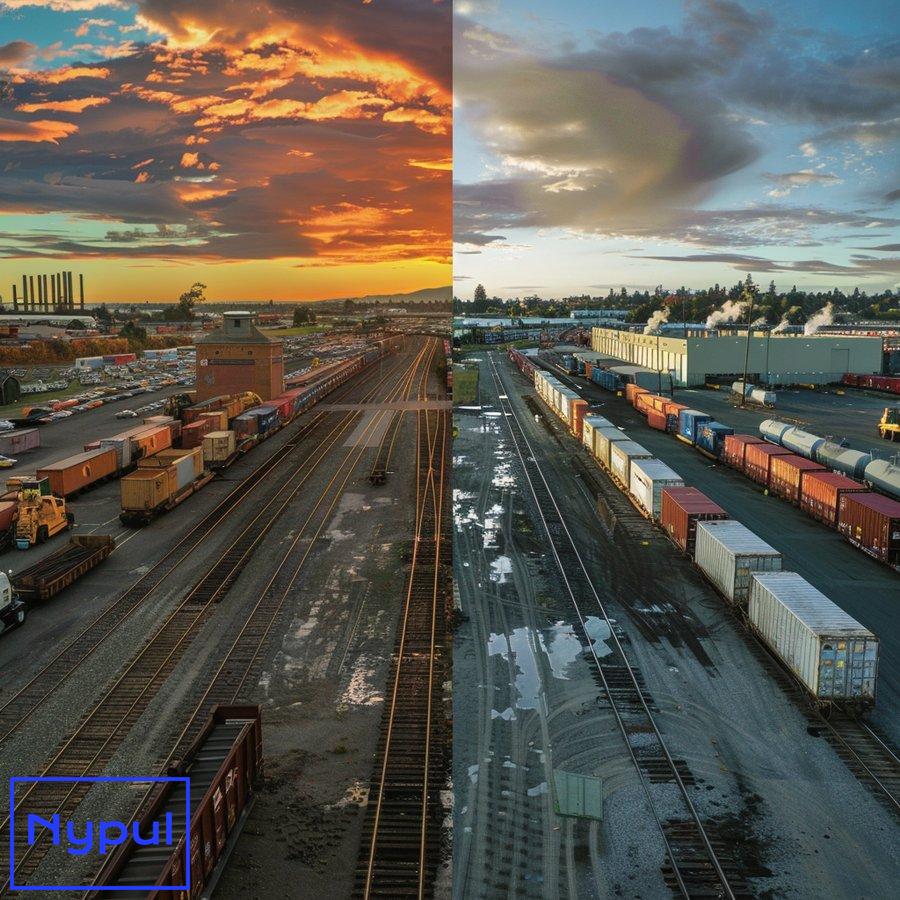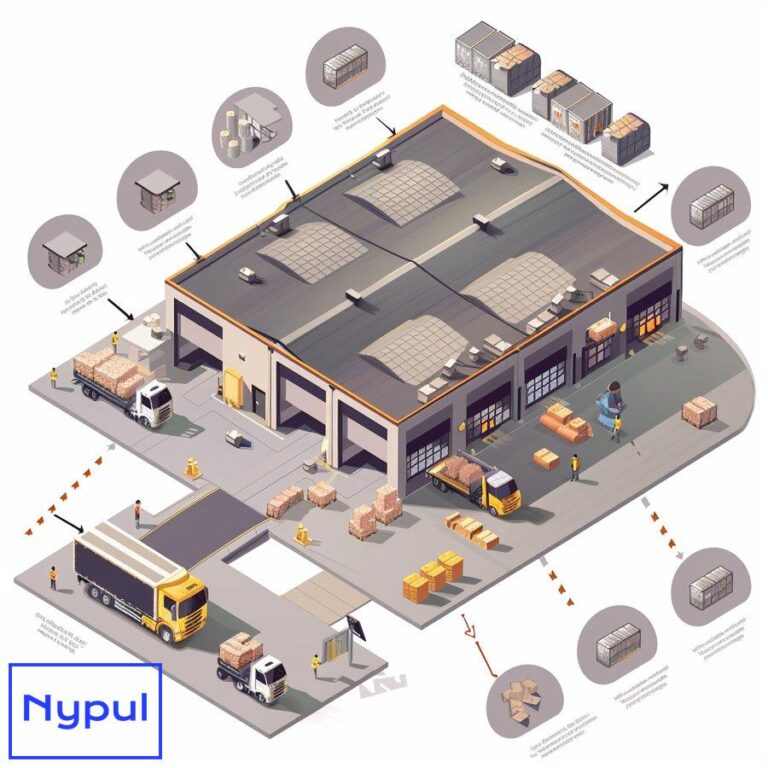What Is the Yard Check Process
What is a yard check and why is it important?

A yard check is a systematic process of accounting for and verifying the status of all trailers, containers, and other assets within a logistics facility’s yard. This critical operation involves physically inspecting and documenting the location, condition, and contents of each asset to ensure accurate inventory management and efficient yard operations.
Yard checks serve as the eyes and ears of logistics operations, providing real-time visibility into the movement and status of assets. They play a pivotal role in maintaining operational efficiency, reducing costs, and enhancing overall supply chain performance.
The importance of yard checks stems from their ability to:
Prevent lost or misplaced assets
Regular yard checks help identify and locate trailers or containers that may have been misplaced or forgotten, preventing costly delays and improving asset utilization.
Enhance security
By maintaining a close watch on yard assets, companies can detect and prevent theft, unauthorized access, or tampering with cargo.
Improve inventory accuracy
Accurate yard checks ensure that the physical inventory matches digital records, reducing discrepancies and improving overall inventory management.
Optimize yard space
Understanding the exact location and status of assets allows for better space utilization and more efficient yard operations.
Reduce detention and demurrage costs
Regular checks help identify assets nearing detention or demurrage thresholds, allowing companies to take proactive measures to avoid unnecessary charges.
Support compliance
Yard checks assist in maintaining compliance with regulatory requirements by ensuring proper documentation and tracking of assets.
Enhance customer service
Accurate yard data enables companies to provide timely and precise information to customers about their shipments.
Facilitate better decision-making
Up-to-date yard information supports informed decision-making in areas such as resource allocation, scheduling, and capacity planning.
The yard check process forms the foundation of effective yard management. By providing accurate, real-time data on asset status and location, yard checks enable logistics professionals to make informed decisions, optimize operations, and maintain a competitive edge in the fast-paced world of supply chain management.
How does the yard check process work?
The yard check process is a structured approach to monitoring and managing assets within a logistics facility’s yard. While specific procedures may vary depending on the size of the operation and available technology, the core steps remain consistent across most yard check processes.
Planning and preparation
Before conducting a yard check, logistics teams typically plan the timing and frequency of checks. This may involve scheduling regular checks (e.g., daily, weekly) or conducting ad-hoc checks based on operational needs. The team also prepares necessary tools and documentation for the check.
Physical inspection
During this phase, yard personnel physically walk through the yard, visually inspecting each trailer, container, or asset. They verify the asset’s location, condition, and any identifying information such as trailer numbers or seal integrity.
Data collection
As assets are inspected, relevant information is recorded. This may include:
– Asset identification (e.g., trailer number, container ID)
– Location within the yard
– Status (e.g., empty, loaded, damaged)
– Contents (if applicable)
– Arrival or departure dates
– Any discrepancies or issues noted
Verification against records
The collected data is compared against existing records in the yard management system or other tracking tools. This step helps identify any discrepancies between physical observations and digital records.
Updating systems
Based on the verification results, yard management systems and other relevant databases are updated to reflect the current status and location of assets. This ensures that all stakeholders have access to accurate, up-to-date information.
Reporting and analysis
After completing the yard check, reports are generated summarizing the findings. These reports may include:
– Total asset count
– Asset status breakdown
– Discrepancies identified
– Issues requiring attention (e.g., damaged assets, expired seals)
Action planning
Based on the yard check results, logistics teams develop action plans to address any issues identified. This may involve relocating assets, scheduling maintenance, or updating inventory records.
Communication
Relevant stakeholders are informed of the yard check results and any actions required. This may include operations managers, customer service teams, and external partners such as carriers or customers.
Follow-up
The logistics team follows up on action items identified during the yard check, ensuring that issues are resolved and improvements are implemented.
The yard check process works as a continuous cycle, with each check building on the insights and improvements from previous checks. This iterative approach allows logistics operations to maintain high levels of accuracy and efficiency in their yard management practices.
What are the key components of an effective yard check?
An effective yard check comprises several crucial components that work together to ensure accuracy, efficiency, and value for logistics operations. These key components form the backbone of a robust yard check process:

Comprehensive asset inventory
A thorough yard check must account for all assets present in the yard, including:
– Trailers (both loaded and empty)
– Containers
– Chassis
– Yard trucks or spotters
– Other equipment or materials stored in the yard
Accurate location tracking
Precise identification of each asset’s location within the yard is critical. This may involve:
– Using a standardized yard map or grid system
– Employing GPS or RFID technology for automated location tracking
– Implementing a clear naming convention for yard zones or parking spots
Detailed asset information
Collecting comprehensive data about each asset ensures a complete picture of yard status:
– Asset identification (e.g., trailer number, license plate)
– Asset type and specifications
– Current status (e.g., loaded, empty, damaged, out of service)
– Contents (if loaded)
– Arrival date and time
– Scheduled departure or next move
– Any special handling requirements or restrictions
Condition assessment
Evaluating the physical condition of assets during yard checks helps identify maintenance needs and potential safety issues:
– Structural integrity
– Tire condition
– Damage assessment
– Cleanliness and readiness for use
Seal verification
For loaded trailers or containers, checking seal integrity is crucial for security and compliance:
– Seal presence and condition
– Seal number verification against documentation
– Any signs of tampering or unauthorized access
Documentation review
Verifying and updating relevant documentation ensures compliance and supports efficient operations:
– Bills of lading
– Customs documentation
– Hazardous materials declarations
– Maintenance records
Time-stamping
Recording the exact time of each asset check provides a clear audit trail and supports accurate tracking:
– Check-in and check-out times
– Duration of stay in the yard
– Time since last movement or inspection
Discrepancy identification
Noting and categorizing any discrepancies found during the check is essential for problem-solving and continuous improvement:
– Misplaced assets
– Damaged equipment
– Missing or incorrect documentation
– Unexpected contents or conditions
Integration with yard management systems
Effective yard checks should seamlessly integrate with existing yard management software:
– Real-time data updates
– Automated alerts for issues or discrepancies
– Historical data tracking for trend analysis
Standardized procedures and checklists
Implementing consistent processes across all yard checks ensures reliability and completeness:
– Step-by-step check procedures
– Standardized data collection forms or digital input methods
– Clear guidelines for handling exceptions or issues
Training and competency
Ensuring that personnel conducting yard checks are properly trained and equipped:
– Knowledge of yard layout and processes
– Familiarity with asset types and documentation
– Proficiency in using yard management tools and technologies
Safety considerations
Incorporating safety measures into the yard check process protects personnel and assets:
– Personal protective equipment requirements
– Traffic management in the yard
– Procedures for handling hazardous materials or damaged equipment
By incorporating these key components, logistics operations can develop a comprehensive and effective yard check process that supports efficient yard management, enhances visibility, and drives continuous improvement in their supply chain operations.
Which tools and technologies are used in modern yard checks?
Modern yard checks leverage a variety of advanced tools and technologies to enhance accuracy, efficiency, and real-time visibility. These innovations have transformed traditional manual processes into streamlined, data-driven operations. Here are the key tools and technologies employed in contemporary yard checks:
Radio Frequency Identification (RFID)
RFID technology uses radio waves to automatically identify and track tagged assets in the yard:
– RFID tags attached to trailers, containers, and equipment
– RFID readers at yard entry/exit points and strategic locations
– Real-time asset tracking and automated data collection
– Reduced manual data entry and improved accuracy
Global Positioning System (GPS)
GPS technology provides precise location data for assets within the yard:
– GPS trackers installed on trailers and yard equipment
– Real-time location updates and movement tracking
– Geofencing capabilities for yard zone management
– Integration with yard management systems for automated updates
Mobile devices and applications
Smartphones and tablets equipped with specialized apps support mobile yard checks:
– Digital data collection forms and checklists
– Barcode and QR code scanning capabilities
– Real-time data synchronization with central systems
– Photo and video documentation of asset conditions
Yard Management Systems (YMS)
Comprehensive software solutions designed specifically for yard operations:
– Real-time visibility of yard assets and their status
– Automated scheduling and dispatching of yard moves
– Integration with warehouse and transportation management systems
– Analytics and reporting capabilities for performance optimization
Internet of Things (IoT) sensors
IoT devices provide continuous monitoring of asset conditions and environmental factors:
– Temperature and humidity sensors for refrigerated trailers
– Door sensors for security monitoring
– Tire pressure and brake wear sensors for maintenance tracking
– Fuel level sensors for yard trucks and generators
Drones
Unmanned aerial vehicles (UAVs) offer a bird’s-eye view of yard operations:
– Aerial surveys of yard layout and asset positioning
– Automated inventory counts using image recognition
– Inspection of hard-to-reach areas or assets
– Enhanced security monitoring and perimeter checks
Artificial Intelligence (AI) and Machine Learning (ML)
AI and ML technologies enhance data analysis and decision-making in yard operations:
– Predictive analytics for optimizing yard moves and asset utilization
– Anomaly detection for identifying unusual patterns or potential issues
– Automated image recognition for asset identification and condition assessment
– Intelligent scheduling and resource allocation
Optical Character Recognition (OCR)
OCR technology automates the reading and recording of asset identification numbers:
– Automated capture of trailer numbers and license plates
– Reduced manual data entry errors
– Faster check-in and check-out processes
– Integration with yard management systems for real-time updates
Bluetooth Low Energy (BLE) beacons
BLE beacons provide precise indoor and outdoor asset location tracking:
– Low-cost, battery-operated devices attached to assets
– Accurate position tracking within yard zones
– Integration with mobile devices for easy asset location
– Enhanced visibility in large or complex yard layouts
Cloud-based platforms
Cloud technology enables centralized data storage and access:
– Real-time data synchronization across multiple devices and locations
– Scalable storage for historical yard check data
– Remote access to yard information for stakeholders
– Enhanced data security and disaster recovery capabilities
Wearable devices
Smart glasses, watches, or other wearables support hands-free yard check operations:
– Augmented reality (AR) displays for asset information overlay
– Voice-activated data entry and commands
– Real-time communication with yard management systems
– Enhanced safety through hands-free operation
Automated gate systems
Intelligent gate systems streamline yard entry and exit processes:
– Automated driver identification and verification
– License plate and container number recognition
– Integration with yard management systems for seamless check-in/out
– Reduced wait times and improved traffic flow
By leveraging these advanced tools and technologies, modern yard checks become more efficient, accurate, and insightful. The integration of these innovations not only streamlines the yard check process but also provides valuable data for continuous improvement and optimization of overall yard operations.
How can yard checks improve overall logistics efficiency?
Yard checks play a crucial role in enhancing overall logistics efficiency by providing accurate, real-time information about yard assets and operations. This information serves as the foundation for optimizing various aspects of the supply chain. Here’s how yard checks contribute to improved logistics efficiency:
Enhanced asset utilization
Regular yard checks help identify underutilized or idle assets:
– Faster turnaround times for trailers and containers
– Reduced dwell times in the yard
– Improved equipment availability for incoming and outgoing shipments
– Optimized fleet size based on actual usage patterns

Streamlined yard operations
Accurate yard data enables more efficient movement and placement of assets:
– Reduced time spent searching for specific trailers or containers
– Optimized yard truck routes for moving assets
– Improved dock door utilization through better trailer positioning
– Reduced congestion and traffic within the yard
Improved inventory management
Yard checks provide real-time visibility into inventory levels and locations:
– Reduced risk of stock-outs or overstocking
– Faster order fulfillment through improved inventory accuracy
– Enhanced ability to prioritize shipments based on inventory status
– Reduced carrying costs through better inventory control
Reduced detention and demurrage costs
Regular checks help identify assets approaching detention or demurrage thresholds:
– Proactive management of trailer and container dwell times
– Reduced fees associated with extended equipment use
– Improved carrier relationships through faster equipment returns
– Enhanced ability to negotiate favorable terms with carriers
Optimized labor allocation
Accurate yard data supports more efficient workforce planning:
– Better forecasting of labor needs based on yard activity
– Reduced idle time for yard personnel
– Improved task prioritization and assignment
– Enhanced productivity through data-driven performance metrics
Improved dock scheduling
Yard checks provide crucial information for optimizing dock operations:
– More accurate appointment scheduling based on actual yard conditions
– Reduced wait times for drivers at facility gates
– Improved coordination between yard moves and dock activities
– Enhanced ability to handle unexpected arrivals or changes in schedules
Enhanced security and loss prevention
Regular yard checks help identify and prevent security issues:
– Faster detection of missing or misplaced assets
– Reduced risk of theft or unauthorized access to cargo
– Improved ability to track and recover lost or stolen equipment
– Enhanced compliance with security regulations and customer requirements
Better maintenance management
Yard checks support proactive equipment maintenance:
– Early identification of damaged or malfunctioning assets
– Improved scheduling of preventive maintenance activities
– Reduced downtime due to equipment failures
– Enhanced safety through regular condition assessments
Improved customer service
Accurate yard data enables better communication with customers:
– Real-time updates on shipment status and location
– Faster response times to customer inquiries
– Improved ability to handle special requests or urgent shipments
– Enhanced customer satisfaction through increased reliability and transparency
Data-driven decision making
Regular yard checks generate valuable data for strategic planning:
– Identification of trends and patterns in yard operations
– Improved forecasting of capacity needs and resource requirements
– Data-backed justification for investments in yard improvements
– Continuous optimization of yard layouts and processes
Enhanced compliance and auditing
Yard checks support regulatory compliance and internal auditing processes:
– Improved tracking of hazardous materials and special handling requirements
– Enhanced ability to meet customs and border protection regulations
– Better documentation for insurance and liability purposes
– Streamlined auditing processes through accurate, historical yard data
Reduced environmental impact
Efficient yard operations supported by regular checks can reduce environmental footprint:
– Decreased fuel consumption through optimized yard truck movements
– Reduced idling time for trucks waiting to enter or exit the facility
– Improved energy efficiency through better utilization of yard lighting and equipment
– Enhanced ability to implement and track green initiatives in yard operations
By improving these various aspects of logistics operations, yard checks contribute significantly to overall efficiency gains. The ripple effect of these improvements extends beyond the yard itself, positively impacting the entire supply chain and ultimately leading to cost savings, improved service levels, and enhanced competitiveness for logistics providers and their clients.
What challenges do logistics professionals face during yard checks?
Logistics professionals encounter various challenges when conducting yard checks, which can impact the accuracy, efficiency, and effectiveness of the process. Understanding these challenges is crucial for developing strategies to overcome them and optimize yard management practices. Here are the key challenges faced during yard checks:
Time constraints
Yard checks often need to be completed within tight timeframes:
– Pressure to minimize disruption to ongoing yard operations
– Need to balance thoroughness with speed
– Challenges in coordinating checks with other yard activities
– Difficulty in scheduling checks during peak operational periods
Large yard sizes and complex layouts
Extensive or intricate yard layouts can complicate the check process:
– Time-consuming to cover large areas on foot
– Difficulty in maintaining a systematic approach in complex layouts
– Challenges in accurately recording asset locations in multi-zone yards
– Increased risk of missing or overlooking assets in remote or obscured areas
Dynamic yard environments
Constant movement of assets in busy yards poses challenges:
– Difficulty in capturing an accurate “snapshot” of yard status
– Risk of double-counting or missing assets due to ongoing movements
– Challenges in coordinating checks with yard truck operations
– Need for real-time updates to account for changes during the check process
Weather and environmental factors
Outdoor yard checks are subject to weather-related challenges:
– Reduced visibility in poor weather conditions (rain, fog, snow)
– Extreme temperatures affecting personnel comfort and equipment functionality
– Challenges in using electronic devices in wet or dusty conditions
–Safety concerns
Conducting yard checks involves navigating potentially hazardous environments:
– Risks associated with moving vehicles and equipment in the yard
– Need for personnel to be vigilant and aware of surroundings
– Requirement for personal protective equipment (PPE) to ensure safety
– Challenges in maintaining safety protocols during busy periods
Data accuracy and integrity
Ensuring accurate data collection and management is a significant challenge:
– Potential for human error during manual data entry
– Discrepancies between physical counts and digital records
– Need for regular audits and reconciliations to maintain data integrity
– Difficulty in verifying the accuracy of documentation associated with assets
Resource limitations
Logistics teams may face constraints in personnel and tools:
– Insufficient staffing to conduct comprehensive yard checks
– Limited access to technology or tools for efficient data collection
– Budget constraints impacting the ability to invest in advanced yard management systems
– Challenges in training personnel on new technologies or processes
Integration with existing systems
Yard checks must align with broader logistics and inventory management systems:
– Difficulty in integrating yard management software with other operational tools
– Challenges in ensuring real-time data synchronization across platforms
– Need for standardized processes to facilitate smooth communication between systems
– Potential for resistance to change from personnel accustomed to legacy systems
Communication challenges
Effective communication is essential for successful yard checks:
– Coordination between different teams (yard, operations, transportation)
– Ensuring all stakeholders are informed of yard check schedules and results
– Difficulty in relaying real-time updates to relevant parties
– Potential for miscommunication leading to operational inefficiencies
Regulatory compliance
Adhering to regulatory requirements adds complexity to yard checks:
– Need to comply with safety, environmental, and transportation regulations
– Challenges in maintaining accurate documentation for audits and inspections
– Potential penalties for non-compliance affecting operational efficiency
– Requirement for ongoing training to keep staff informed of regulatory changes
By understanding and addressing these challenges, logistics professionals can enhance the effectiveness of yard checks and improve overall yard management practices. Proactive strategies, such as investing in technology, optimizing processes, and providing training, can help mitigate these challenges and lead to more efficient yard operations.
How do yard checks impact inventory management and cost reduction?
Yard checks significantly influence inventory management and cost reduction in logistics operations. By providing accurate data and insights into asset status, yard checks enable organizations to optimize their inventory practices and reduce unnecessary expenses. Here are the key ways in which yard checks impact inventory management and cost reduction:
Accurate inventory visibility
Regular yard checks ensure that organizations have a clear understanding of their inventory levels:
– Real-time data on the status and location of trailers, containers, and equipment
– Reduced discrepancies between physical counts and digital records
– Improved ability to track inventory turnover and identify slow-moving assets
– Enhanced forecasting capabilities based on accurate inventory data
Reduction of stock-outs and overstocking
Yard checks help prevent stock-outs and overstock situations:
– Timely identification of inventory needs based on yard check results
– Improved ability to balance supply and demand through accurate data
– Enhanced decision-making regarding reordering and inventory replenishment
– Reduced carrying costs associated with excess inventory
Streamlined order fulfillment
Accurate inventory information from yard checks supports efficient order fulfillment:
– Faster identification of available inventory for customer orders
– Improved ability to prioritize shipments based on inventory status
– Enhanced coordination between yard operations and warehouse activities
– Reduced lead times for order processing and delivery
Minimized carrying costs
Yard checks contribute to minimizing carrying costs through better inventory management:
– Reduced need for additional storage space due to accurate inventory tracking
– Lower costs associated with insurance and inventory holding
– Enhanced ability to implement just-in-time inventory practices
– Improved cash flow through optimized inventory levels
Enhanced asset utilization
Yard checks help organizations maximize the utilization of their assets:
– Identification of underutilized or idle trailers and containers
– Improved scheduling of asset movements to reduce dwell times
– Enhanced ability to allocate resources effectively based on real-time data
– Reduced costs associated with maintaining excess equipment
Cost-effective maintenance management
Regular yard checks support proactive maintenance practices:
– Early identification of damaged or malfunctioning assets
– Improved scheduling of maintenance activities to minimize downtime
– Reduced repair costs through timely interventions
– Enhanced safety and compliance through regular condition assessments
Improved decision-making
Yard checks provide valuable data for informed decision-making:
– Enhanced ability to analyze trends and patterns in inventory usage
– Data-driven insights for optimizing inventory levels and asset allocation
– Improved forecasting accuracy based on historical yard check data
– Enhanced ability to adapt to changing market conditions and customer demands
Reduction of theft and loss
Regular yard checks help mitigate the risk of theft and loss:
– Enhanced security measures through consistent monitoring of assets
– Faster identification of missing or misplaced inventory
– Improved ability to recover lost or stolen assets through accurate tracking
– Reduced costs associated with theft and loss prevention measures
Optimized supply chain collaboration
Yard checks facilitate better collaboration across the supply chain:
– Improved communication and information sharing among stakeholders
– Enhanced ability to coordinate inventory management efforts with suppliers and customers
– Reduced delays and disruptions through accurate inventory visibility
– Improved relationships with partners through reliable inventory data
By positively impacting inventory management and driving cost reduction, yard checks become a vital component of efficient logistics operations. Organizations that prioritize regular and accurate yard checks can achieve significant savings, improved service levels, and enhanced competitiveness in the marketplace.
What role do yard checks play in enhancing supply chain visibility?
Yard checks are instrumental in enhancing supply chain visibility by providing real-time data and insights into the status and location of assets within a logistics facility. This visibility is crucial for effective decision-making, coordination, and overall supply chain performance. Here are the key roles that yard checks play in enhancing supply chain visibility:
Real-time asset tracking
Yard checks enable organizations to maintain real-time visibility of their assets:
– Accurate tracking of trailers, containers, and equipment within the yard
– Immediate updates on asset status, including loading and unloading activities
– Enhanced ability to monitor asset movements in and out of the yard
– Improved coordination with transportation and warehouse operations
Improved communication
Regular yard checks facilitate better communication among supply chain stakeholders:
– Timely sharing of yard check results with relevant teams (operations, customer service, transportation)
– Enhanced ability to relay real-time updates to customers regarding shipment status
– Improved collaboration with carriers and suppliers through shared visibility
– Reduced misunderstandings and miscommunications that can lead to delays
Data-driven decision-making
Yard checks provide valuable data that supports informed decision-making:
– Accurate insights into inventory levels, asset utilization, and operational efficiency
– Enhanced ability to analyze trends and patterns for strategic planning
– Improved forecasting capabilities based on real-time yard data
– Better resource allocation and scheduling based on visibility into yard operations
Identification of bottlenecks
Regular yard checks help identify bottlenecks and inefficiencies in the supply chain:
– Timely detection of delays in asset movement or processing
– Enhanced ability to address issues before they escalate into larger problems
– Improved visibility into the root causes of operational inefficiencies
– Data-driven insights for continuous improvement initiatives
Enhanced customer service
Yard checks contribute to improved customer service through enhanced visibility:
– Accurate and timely updates on shipment status and expected delivery times
– Improved ability to respond to customer inquiries and requests
– Enhanced reliability and transparency in the supply chain
– Increased customer satisfaction through better service levels
Support for compliance and reporting
Yard checks play a vital role in ensuring compliance and supporting reporting requirements:
– Accurate documentation of asset status and movements for regulatory compliance
– Enhanced ability to provide necessary information for audits and inspections
– Improved tracking of hazardous materials and special handling requirements
– Better visibility into inventory levels for financial reporting and analysis
Facilitation of risk management
Yard checks enhance visibility into potential risks within the supply chain:
– Timely identification of security concerns, such as theft or damage
– Improved ability to assess and mitigate risks associated with inventory management
– Enhanced visibility into external factors that may impact supply chain operations
– Better preparedness for unexpected disruptions or challenges
Collaboration with technology
Yard checks can be integrated with advanced technologies to enhance visibility:
– Real-time data synchronization with yard management systems and other tools
– Enhanced tracking capabilities through RFID, GPS, and IoT devices
– Improved data analytics for generating insights and trends
– Seamless communication between systems for better visibility across the supply chain
Continuous improvement
Regular yard checks support a culture of continuous improvement within the supply chain:
– Data-driven insights for identifying areas of improvement in yard operations
– Enhanced ability to implement best practices and optimize processes
– Improved visibility into the effectiveness of improvement initiatives
– Better alignment of supply chain objectives with overall business goals
By enhancing supply chain visibility, yard checks empower logistics professionals to make informed decisions, improve operational efficiency, and deliver superior service to customers. Organizations that prioritize visibility through regular yard checks can achieve a competitive advantage in today’s dynamic supply chain landscape.
How can companies integrate yard checks with their transportation management systems?
Integrating yard checks with transportation management systems (TMS) is essential for optimizing logistics operations and enhancing overall efficiency. This integration enables seamless data flow between yard management and transportation processes, resulting in improved visibility, coordination, and decision-making. Here are the key steps and considerations for successfully integrating yard checks with TMS:

Define integration objectives
Before initiating the integration process, companies should define their objectives:
– Identify specific goals for integrating yard checks with TMS (e.g., improved visibility, reduced delays)
– Determine key performance indicators (KPIs) to measure integration success
– Align integration objectives with overall logistics and supply chain strategies
Assess existing systems
A thorough assessment of current yard management and TMS capabilities is crucial:
– Evaluate the functionality and compatibility of existing systems
– Identify gaps or limitations in current processes that integration could address
– Determine the level of customization required for successful integration
Choose the right integration approach
Companies can choose from several integration approaches based on their needs:
– API Integration: Utilize application programming interfaces (APIs) to enable real-time data exchange between yard management systems and TMS.
– Middleware Solutions: Implement middleware platforms that facilitate communication between different systems, ensuring data consistency and synchronization.
– Custom Development: Develop custom integration solutions tailored to specific business requirements and workflows.
Implement data synchronization
Establishing real-time data synchronization is critical for successful integration:
– Ensure that yard check data is automatically updated in the TMS as checks are completed.
– Enable two-way data flow to allow updates from TMS to reflect changes in yard operations.
– Implement automated alerts and notifications for relevant stakeholders based on yard check results.
Standardize data formats
Consistent data formats are essential for seamless integration:
– Define standardized data formats for asset identification, status, and location.
– Ensure that both yard management and TMS use compatible data structures for easy exchange.
– Implement data validation processes to minimize errors during data transfer.
Train personnel
Proper training is vital for successful integration and adoption:
– Provide training for staff on using integrated systems and new workflows.
– Ensure that personnel understand the importance of accurate data entry and updates.
– Foster a culture of collaboration between yard and transportation teams to maximize integration benefits.
Monitor and evaluate integration performance
Regular monitoring and evaluation of integration performance are essential:
– Track KPIs established during the integration planning phase.
– Gather feedback from users to identify areas for improvement.
– Make necessary adjustments to optimize integration processes over time.
Enhance visibility and reporting
Integration should lead to improved visibility and reporting capabilities:
– Develop dashboards and reporting tools that provide real-time insights into yard and transportation operations.
– Enable stakeholders to access key metrics and performance indicators related to yard checks and transportation activities.
– Use data analytics to identify trends and opportunities for further optimization.
Continuous improvement
Integration is an ongoing process that requires continuous improvement:
– Regularly assess the effectiveness of the integration and make adjustments as needed.
– Stay informed about advancements in yard management and TMS technologies.
– Explore opportunities for further integration with other systems, such as warehouse management systems (WMS) and enterprise resource planning (ERP) systems.
By effectively integrating yard checks with transportation management systems, companies can enhance operational efficiency, improve communication, and achieve greater visibility across their logistics operations. This integration ultimately leads to better decision-making, reduced costs, and improved service levels for customers.





